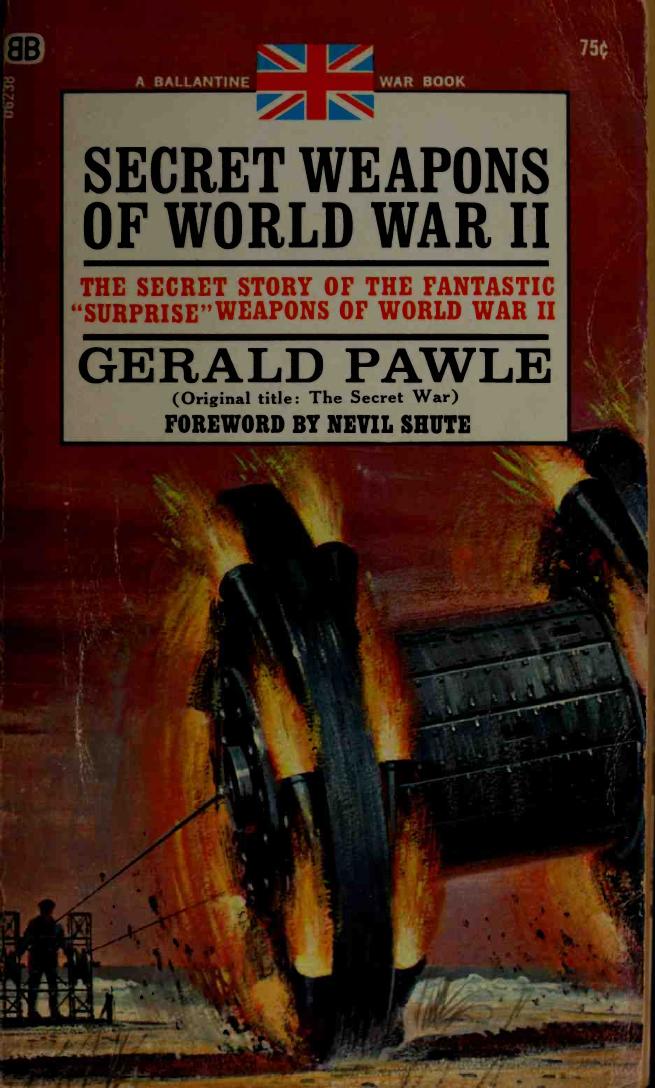Secret Weapons of World War II by Gerald Pawle

Author:Gerald Pawle
Language: eng
Format: epub, pdf
Publisher: Arcadia Press
Published: 2017-08-18T04:00:00+00:00
14
HARRYING THE U-BOATS
THE story of the pier has taken us ahead of events. Invasion of Europe was a far-distant prospect when trials began at Birnbeck, for Britain and the remnant forces of her allies still stood alone, and very survival hung on the outcome of the war at sea. In the eight weeks of May and June 1941 enemy submarines sank 119 ships totalling 635,635 tons. From all causes the Allies lost nearly a million tons of shipping during this brief period.
In the Admiralty a special committee, under Professor P. M. S. Blackett, was formed to investigate all possible means of attacking submarines, and Norway, who attended several of its meetings, repeatedly pressed for the use of rockets. He had discussed with Goodeve, several months earlier, an idea for mounting 2-inch rockets under the wings of Swordfish aircraft, and using them to attack oil-storage tanks and similar targets, but at the time there was no scope for the Fleet Air Arm in such a role and nothing came of the proposal.
He now returned to the charge. The weapon he had in mind was a very simple affair — a rocket-propelled spear with a cast-iron, fluted head which would rip a large hole in the pressure hull of a U-boat — but perhaps its very simplicity told against it. The minds of the committee seemed fixed on more refined and scientific devices, and even Goodeve, who was attracted to the idea, was not altogether satisfied that Norway’s theory could be translated into practice.
“Why on earth shouldn’t it work?” said Norway testily, after one particularly abortive meeting in the Admiralty. “You can spear a fish quite successfully, and the principle is exactly the same. There was nothing wrong with the trials we did in the tank at Teddington.”
“I know there wasn’t,” Goodeve admitted, “but I still don’t think it will keep straight after impact. It will turn over.”
They gave the Rocket Spear some more ambitious tests at Birnbeck. It emerged triumphantly, and after that Goodeve was no longer sceptical. But outside D.M.W.D. no one showed any interest in the weapon, and it was not until the Army asked for rockets to be tried as anti-tank missiles that Norway got a chance to justify his claims.
For the anti-tank trials the R.A.F. allocated a Hurricane, and somewhat reluctantly they agreed to test the Spear against submarine plating at the same time.
Among those who heard of the trials about to take place was Admiral Sir Max Horton, who as Commander-in-Chief, Western Approaches, was now directing the Battle of the Atlantic from his headquarters at Liverpool. Horton was “that rara avis among admirals, a technician who had completely mastered the scientific discoveries and devices brought in to aid ships and aircraft engaged in the battle against the U-boats.” And he immediately dispatched one of his staff, Commander Phillimore, to Boscombe Down to see if the Rocket Spear had possibilities. Phillimore was greatly impressed by the trials, and when he reported enthusiastically on the new weapon Horton at once urged the Admiralty to adopt it.
Download
Secret Weapons of World War II by Gerald Pawle.pdf
This site does not store any files on its server. We only index and link to content provided by other sites. Please contact the content providers to delete copyright contents if any and email us, we'll remove relevant links or contents immediately.
| Africa | Americas |
| Arctic & Antarctica | Asia |
| Australia & Oceania | Europe |
| Middle East | Russia |
| United States | World |
| Ancient Civilizations | Military |
| Historical Study & Educational Resources |
The Radium Girls by Kate Moore(11887)
100 Deadly Skills by Clint Emerson(4816)
Rise and Kill First by Ronen Bergman(4670)
The Templars by Dan Jones(4611)
The Doomsday Machine by Daniel Ellsberg(4388)
The Rape of Nanking by Iris Chang(4117)
Killing England by Bill O'Reilly(3936)
Hitler in Los Angeles by Steven J. Ross(3881)
Stalin by Stephen Kotkin(3844)
12 Strong by Doug Stanton(3472)
Hitler's Monsters by Eric Kurlander(3252)
Blood and Sand by Alex Von Tunzelmann(3113)
Darkest Hour by Anthony McCarten(3052)
The Code Book by Simon Singh(3045)
The Art of War Visualized by Jessica Hagy(2909)
Hitler's Flying Saucers: A Guide to German Flying Discs of the Second World War by Stevens Henry(2681)
Babylon's Ark by Lawrence Anthony(2519)
The Second World Wars by Victor Davis Hanson(2463)
Tobruk by Peter Fitzsimons(2427)
